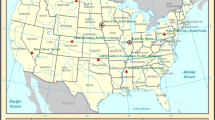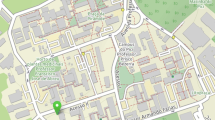Abstract
Two different models, a Physical Model and a Neural Net (NN), are used for the derivation of the Photosynthetically Available Radiation (PAR) from METEOSAT data in the German Bight; advantages and disadvantages of both models are discussed. The use of a NN for derivation of PAR should be preferred to the Physical Model because by construction, a NN can take the various processes determining PAR on a surface much better into account than a non-statistical model relying on averaged relations.






Similar content being viewed by others
Notes
Kipp & Zonen ‘PAR Lite’ Photosynthetic Active Radiometer
Kipp & Zonen ‘CM11’ Pyranometer
References
Bishop CM (1995) Neural Networks for pattern recognition. Clarendon
Dumortier D (1995) Modelling global and diffuse horizontal irradiances under cloudless skies with different turbidities. Daylight II, JOU2-CT92-0144, Final Report Vol 2
Fontoynont M, Dumortier D, Heinemann D, Hammer A, Olseth J, Skartveit A, Inneichen P, Reise C, Page J, Roche L, Beyer HG, Wald L (1998) Satellight: a WWW server which provides high quality daylight and solar radiation data for Western and Central Europe. Proc. 9th conference on satellite meteorology and oceanography, Paris, 25–29 May 1998, pp 434–437
Frouin R, Gautier C, Lingner DW, Baker KS, Smith RC J (1989) A simple analytical formula to compute clear sky total and photosynthetically available solar irradiance at the ocean surface. J Geophys Res 94(C7):9731–9742
Hammer A, Heinemann D, Westerhellweg A (1998) Daylight and solar irradiance data derived from satellite observations—the satellight project. Proc. 9th conference on satellite meteorology and oceanography, Paris, 25–29 May 1998, 747–750
Iqbal M (1983) An introduction to solar radiation. Academic
JGOFS Report No. 36 (2002) Photosynthesis and primary production in marine ecosystems: practical aspects and application of techniques. ISSN 1016–7331
Kasten F (1996) The Linke turbidity factor based on improved values of the integral Rayleigh optical thickness. Sol Energy 56:239–244
Kasten F, Young AT (1989) Revised optical air mass tables and approximation formula. Appl Opt 28:4735–4738
Lacis AA, Hansen JE (1974) A parametrization for the absorption of solar radiation in the earth’s atmosphere. J Atmos Sci 31(1):118–133
Lòpez G, Rubio MA, Batlles FJ (2001) Estimation of hourly global photosynthetically active radiation using artificial Neural Network models. Agric For Meteorol 107:279–291
Mobley CD (1994) Ligth and water-radiative transfer in natural waters. Academic, p 36
Olseth JA, Skartveit A (2001) Solar irradiance, sunshine duration and daylight illuminance derived from METEOSAT data for some European sites. Theor Appl Climatol 69:239–252
Page J (1996) Algorithms for the Satellight programme. Technical Report
Rossow WB, Schiffer RA (1999) Advances in understanding clouds from ISCCP. Bull Am Meteorol Soc 80(11):2261–2287
Schiller H (2000) Feedforward-backpropagation Neural Net program ffbp1.0. GKSS 2000/37 ISSN 0344–9629
Schiller K (2001) Derivation of the photosynthetically available radiation from METEOSAT data. GKSS 2001/23 ISSN 0344–9629 (The software described within can be obtained from(http://gfesun1.gkss.de/software/meteosat2par)
Tyler JE (ed) (1966) Report on the second meeting of the joint group of experts on photosynthetic radiant energy. UNESCO Tech. Paper. Mar Sci 2:1–11
van Laake PE, Sanchez-Azofeifa GA (2004) Simplified atmospheric transfer modelling for estimating PAR using MODIS atmosphere products. Remote Sens Environ 91:98–113
Acknowledgements
This research was supported by the HGF strategy fund as part of the ENVOC project. The authoress likes to thank Dr. R. Hollmann for helping me getting started, Dr. R. Doerffer, Dr. H. Schiller and Dr. R. Röttgers for the helpful discussions and the EUMETSAT team for the supply of METEOSAT data.
Author information
Authors and Affiliations
Corresponding author
Additional information
Responsible editor: Jörg-Olaf Wolff
Rights and permissions
About this article
Cite this article
Schiller, K. Derivation of Photosynthetically Available Radiation from METEOSAT data in the German Bight with Neural Nets. Ocean Dynamics 56, 79–85 (2006). https://doi.org/10.1007/s10236-006-0058-1
Received:
Accepted:
Published:
Issue Date:
DOI: https://doi.org/10.1007/s10236-006-0058-1




